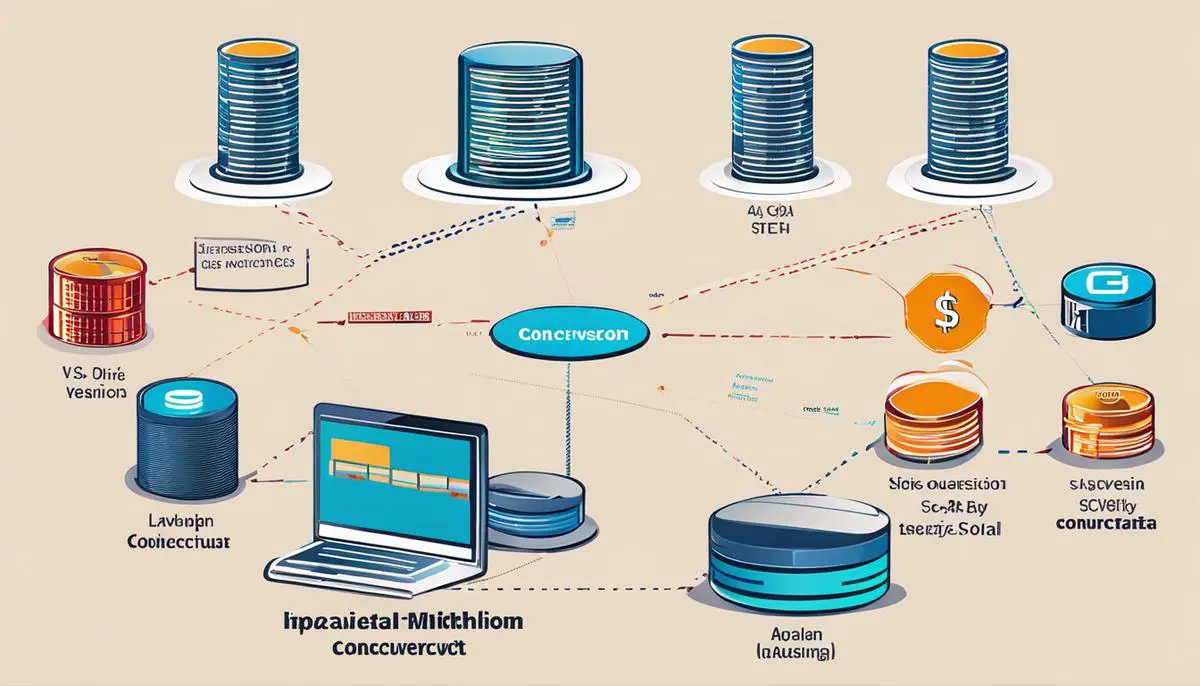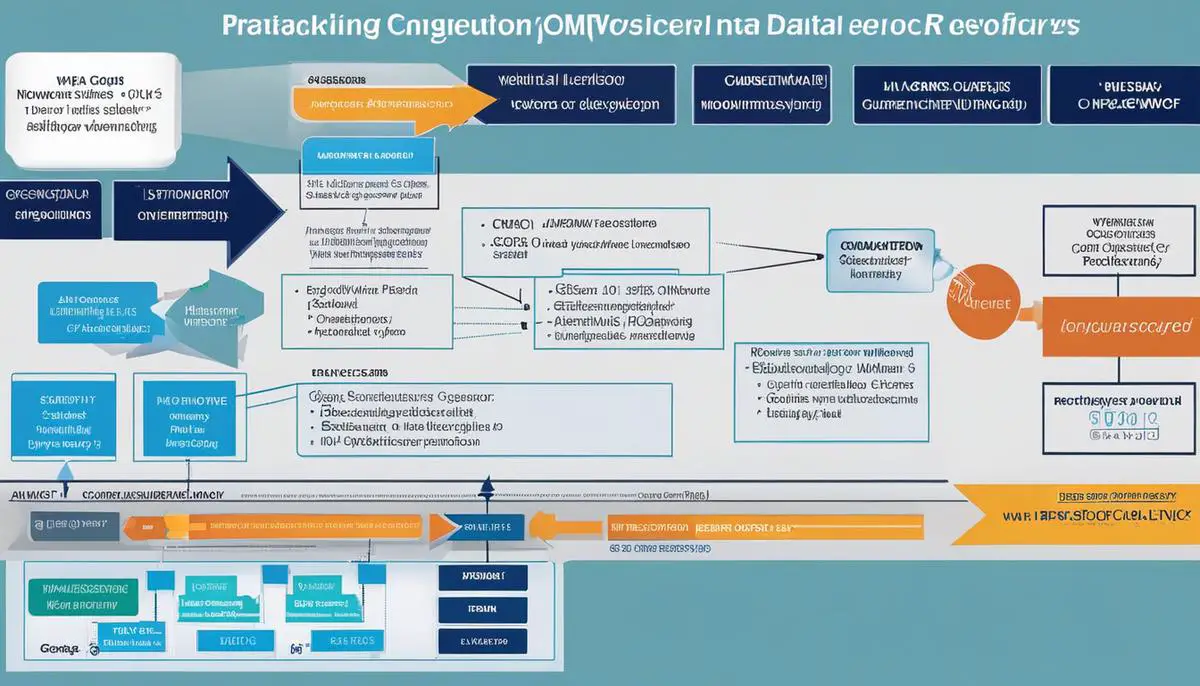In the rapidly evolving world of database management, Multi-Version Concurrency Control (MVCC) emerges as a pivotal technology enabling simultaneous data access amidst growing transactional demands. As we delve into the labyrinth of database consistency and concurrency, MVCC stands as a beacon of efficiency, allowing us to navigate the complexities of modern data operations. This essay seeks to unravel the tapestry of MVCC, from its fundamental principles to the intricate patterns woven by its various implementation strategies. We embark on an intellectual journey to dissect the architecture of MVCC, contrasting it with lock-based concurrency controls and unraveling the nuanced balance it strikes between high performance and data consistency.
Fundamentals of MVCC
Unraveling the Mechanisms of MVCC in Boosting Database Performance
In the realm of cutting-edge database systems, MVCC, or Multi-Version Concurrency Control, stands as a foundational technology that markedly improves performance. This sophisticated method of managing database transactions is pivotal for enabling multiple processes to access data simultaneously without compromising data integrity or system efficiency.
At its core, MVCC creates separate “snapshots” of the database for each active transaction. These snapshots represent the state of the database at a specific point in time. By doing so, the system permits various transactions to interact with these snapshots rather than the live database itself. This technique serves two primary functions: it provides a consistent view of the database to each transaction while mitigating the direct impact these transactions have on one another.
One salient advantage of MVCC is the reduction in waiting time for database access. In traditional locking systems, if one process is using a piece of data, other processes must wait for that lock to be released. This can lead to significant delays, particularly in high-volume database environments. MVCC, conversely, circumvents this bottleneck. It allows reads and writes to occur in parallel by ensuring each transaction interacts with its unique snapshot.
Moreover, MVCC enhances database performance by virtue of its ability to minimize lock contention. In traditional databases, operations regularly compete for locks on the same rows or tables, which can lead to contention and decreased throughput. MVCC sidesteps this contention by rendering exclusive locks unnecessary for read operations—they can safely operate on past versions of the data. Writes do require specific handling, but by employing MVCC, the system ensures these instances are efficiently managed with minimal interference to concurrent activities.
Additionally, MVCC supports versioned histories of data, catering to the needs of complex query operations. This capability is crucial for analyzing trends over time, supporting ‘time-travel’ queries, which can retrieve data as it existed at a previous moment—without halting ongoing transactions.
In conclusion, MVCC dramatically enhances the efficiency and concurrency of database operations. It offers a robust solution to the perennial challenge of managing simultaneous data transactions, thus facilitating smoother, more responsive database interactions that are vital to the operation of contemporary data-driven applications. The adoption of MVCC in database systems continues to play an instrumental role in sustaining high performance in an era characterized by ever-increasing data demands and transaction volumes.

MVCC vs. Lock-Based Concurrency Controls
Multiversion concurrency control (MVCC) stands in contrast to traditional lock-based concurrency controls, which have historically governed the domain of database transactions. Lock-based mechanisms work on the precept of restricting access to data items that are involved in any given transaction, thereby introducing a noticeable rigidity to the transactional flow of operations—operations that are increasingly seen as anachronistic in the era of high-demand, responsive database systems.
Essentially, lock-based systems enforce exclusivity, either through ‘shared locks’ for read operations that allow concurrent reads or more restrictive ‘exclusive locks’ which prevent any other transaction from read or write operations on the locked data. The inherent challenge in this model is the potential for deadlock, where concurrent transactions hold exclusive locks and each waits for the other to release its lock before proceeding. This predicament necessitates the implementation of complex deadlock detection and resolution strategies, which further strain system resources and complicate transaction management.
MVCC forges a different path, standing apart in its non-blocking approach. By allowing multiple, concurrent versions of data, MVCC eschews the rigid control model that lock-based systems rely upon. A direct ramification of this is the implementation of ‘snapshot isolation’. This strategy allows a transaction to operate on a consistent snapshot of the database at the point in time when the transaction began. Consequently, transactions can proceed without directly impacting the operations of others, thus largely eliminating the potential for deadlocks. Readers do not block writers, and writers do not block readers.
Another distinction arises in the process of ‘write skew’, a phenomenon where non-repeatable reads occur in lock-based systems due to the acquisition and release of locks over the duration of a transaction. MVCC sidesteps this challenge by ensuring subsequent reads within a transaction see a consistent state of the database as it was at the beginning, notwithstanding concurrent modifications that may be happening outside of the transaction’s context.
Additionally, lock-based protocols inevitably incur overhead due to the need for lock management—acquiring, tracking, and releasing locks—which grows in complexity with the scale of the database and the volume of concurrent transactions. MVCC reduces this overhead by eliminating the majority of lock management duties, instead relying on version control to manage concurrent access to data. This empowers databases to scale more effectively to support a vast number of concurrent operations without a commensurate increase in contention management overhead.
In summary, MVCC stands as a testament to the evolution of database transaction processing. It exemplifies the shift from contention and restriction to fluidity and breadth, a shift that champions scalability and performance in modern database systems. It is through the lens of MVCC that databases traverse the landscape of ever-increasing demands, ensuring that the data – the quintessence of these systems – remains both accessible and consistent.

Implementation Strategies for MVCC
In considering the multifaceted strategies underpinning Multiversion Concurrency Control (MVCC) in contemporary databases, one must delve into the nuances of temporal control and the management of transactional states. A pivotal strategy leveraged by MVCC hinges on the use of transaction timestamps or transaction IDs to establish a version order amongst transactions. This order facilitates the consistency of concurrent operations without necessitating direct synchronization methods, such as locks.
In the realm of MVCC, the ingenious application of write-ahead logging (WAL) is essential in safeguarding data integrity. By recording changes before they are reflected in the database, WAL ensures that each transaction can be replayed during recovery processes. Consequently, this method preserves the established versions of data records corresponding to active transactions, adding a robust level of fault tolerance.
An advanced MVCC system might also employ a vacuuming process or a similar garbage collection mechanism. This process discerns which versions of data records are obsolete—those that are no longer accessible to any transactions—and purges them judiciously. The strategic removal of such stale data prevents uncontrolled growth of storage requirements and maintains an optimized performance profile.
Algorithms for index management are also an integral component, ensuring that indexes are coherent with the multiple versions of data. Index concurrency strategies must accurately reflect all accessible versions, which can be a sophisticated balancing act between performance and maintenance overhead. The introduction of specialized index structures, such as those enabling a high degree of concurrency or those tailored toward multi-dimensional data, have only further enhanced MVCC’s capabilities.
Moreover, the interplay between hardware characteristics and MVCC algorithms is a contemporary area of active exploration. Database systems are increasingly designed to leverage the parallelism offered by multi-core processors and distributed computing resources. Sophisticated MVCC implementations harness hardware concurrency with algorithms that diminish inter-thread and inter-process contention. This strategic adaptation ensures that the parallel nature of modern hardware architectures is effectively utilized to support high-throughput database operations.
Lastly, sophisticated strategies in MVCC include adaptive heuristics that optimize performance based on observed workload patterns. Such systems intelligently alter the granularity of version control and the aggressiveness of concurrency conflict resolution. These heuristic adjustments can bolster throughput and minimize transactional wait times, particularly in systems with dynamic, unpredictable workloads.
In summary, the implementation of MVCC in contemporary databases is a feat of engineering that blends principles of temporal consistency, forward-thinking algorithm design, and an in-depth understanding of system architecture. MVCC remains a vanguard concept for databases, expertly navigating the landscape of data concurrency and providing a foundation for the scalable, high-performing storage systems that underpin the modern data-driven world.

Isolation Levels in MVCC
Moving beyond the established framework of MultiVersion Concurrency Control (MVCC), where transactions operate with versions of data corresponding to their start time—hence providing temporal control—it becomes essential to delve into the granularity of isolation levels within MVCC and their implications on transaction integrity and system performance.
Isolation levels define the degree to which transactions are isolated from each other, affecting their visibility of intermediate states. In MVCC systems, the common isolation levels from lowest to highest include Read Committed, Repeatable Read, and Serializable.
Read Committed, the lowest isolation level, allows transactions to only see data committed before their execution, preventing dirty reads yet permitting non-repeatable reads and phantom reads. This isolation level balances performance and accuracy, where the simplicity of implementation and reduced overhead from less strict version control contributes to high throughput but at the cost of potential inconsistencies like non-repeatable reads.
Repeatable Read, a step above in isolation restrictiveness, ensures that once a transaction reads data, it will read the same data again even if other transactions commit updates. This is achieved by maintaining a transaction-specific database snapshot from its start time. It reduces the so-called read phenomena but does not eliminate the possibility of phantom reads. The performance implications are notable as maintaining stable snapshots takes resources, possibly impacting system latency, particularly in high contention environments.
Serializable isolation, the most stringent, aims to execute transactions as if serially, one after the other, ensuring total isolation. To implement this in MVCC, systems rely on sophisticated algorithms for detecting serialization inconsistencies such as dependency cycles. At this level, all the aforementioned read phenomena, including phantom reads, are prevented, upholding transaction integrity to its highest. However, the cost is a decrease in concurrency and a potential performance bottleneck due to the complexity of maintaining serializability through version control.
Notably, each increase in isolation level has performance trade-offs, most commonly seen in throughput and latency metrics. One must also consider the costs associated with maintaining version histories and ensuring the correct visibility per the isolation guarantees. The system must cleanse outdated versions (garbage collection), which, if not optimized, can degrade performance.
In practice, real-world systems often default to a lower isolation level, offering a compromise between consistency and performance. Some systems, however, provide mechanisms to dynamically adjust isolation levels or use them selectively based on transactional workload characteristics, achieving a balance between performance and consistency tailored to application needs.
Furthermore, the advent of distributed systems and the integration of cloud computing resources necessitates a discussion of the implications of network latency, partition tolerance, and eventual consistency models on MVCC, which expands upon traditional isolation principles. Nonetheless, these elements lie beyond the scope of this discourse, which maintains focus on the internal mechanisms of MVCC and their operational manifestation in transaction integrity and system performance.
In synthesising the aforesaid, the nuanced control of version histories within MVCC frameworks through differing isolation levels is not a trivial matter. The balance struck between ensuring transactional integrity and fostering optimal system performance is a delicate one, replete with trade-offs that demand astute consideration by database architects and practitioners. Moreover, it exemplifies the intricate complexity inherent in transactional database management systems and underlines the perpetual pursuit of technological advancements in this arena.

Challenges and Limitations of MVCC
Prevalent Challenges and Inherent Limitations of Applying MVCC
Multiversion concurrency control (MVCC) brings forth a considerable advancement in managing database transactions, addressing many limitations inherent in traditional lock-based systems. However, the implementation of MVCC is not without its own technical challenges and constraints that practitioners and database architects must navigate.
One of the notable limitations that arise with the application of MVCC is the increment in storage overhead. As multiple versions of data are maintained to support concurrent access, there is a proportional need for additional disk space. This can result in increased costs for storage resources and potential impacts on database read and write performance. The overhead demands meticulous management, especially in databases with high transaction rates and large data sets.
Moreover, despite the reduction of lock contention, MVCC does not completely eliminate the need for locks, particularly with write operations. The complexity of coordinating writes across multiple versions must be addressed to avoid the “lost update” problem where concurrent transactions overwrite each other’s changes. Consequently, the very act of resolving these conditions can reintroduce contention, albeit less than in lock-based systems.
The sophistication of MVCC’s version management brings forward another layer of complexity: transaction ID wraparound. In systems that employ a finite numerical space for transaction IDs, the eventual wraparound of these numbers poses a risk of misinterpreting the chronological order of transactions. Solutions, such as routine maintenance and ID reclamation processes, are necessary, but they add administrative overhead and the potential for service interruptions.
Regarding performance, while MVCC effectively enhances throughput by reducing waiting times, it does introduce potential latency in scenarios where a transaction’s snapshot becomes considerably outdated due to long-running concurrent transactions. This staleness can affect the relevance of the data being accessed, particularly in systems where real-time decision-making is critical.
The garbage collection of old data versions, an essential maintenance task in MVCC systems, can also present challenges. An inefficient vacuuming process may lead to bloat and degrade performance, necessitating ongoing tuning and optimization to balance resource utilization with system responsiveness.
Furthermore, implementing MVCC in distributed databases adds an extra layer of complexity. Network delays, ensuring consistency across geographically dispersed nodes, and dealing with varying degrees of data recency due to differing local transaction times must be managed with precision. This often requires sophisticated consensus algorithms and can complicate the maintenance of global database states.
Lastly, the practical realities of database administration mean that sometimes compromises must be made in the fidelity of MVCC’s implementation. For instance, a strict adherence to all ACID properties may be relaxed in favor of enhanced performance or scalability, particularly in the context of big data and web-scale applications. Such concessions, while pragmatic, must be carefully considered against the criticality of data consistency in the given application domain.
In conclusion, the application of MVCC is characterized by a delicate balance between optimizing concurrency and managing the implications of additional system complexity. The operative word is balance—achieving the optimal point where concurrency benefits significantly outweigh the multifaceted drawbacks. As this technology continues to evolve, it is the task of dedicated experts in the field to refine MVCC implementations, ensuring they meet the ever-growing demands of modern database systems.

Future Directions in MVCC Research
Current Trajectories in MVCC Research for Database Evolution
Multiversion concurrency control (MVCC) is a foundational component in database systems, enabling multiple transactions to access the same data concurrently without conflict. As such, the research on next-generation databases continues to probe the depths of MVCC, seeking to refine its functionality and extend its application. The ongoing investigations are aimed at addressing several emerging challenges and opportunities within the paradigm.
To begin with, a prime area of exploration is the optimization of storage overhead inherent in MVCC implementations. As each transaction creates new data versions, the storage requirements burgeon, demanding advanced compression algorithms and data deduplication techniques to conserve space while maintaining expedient access to these versions.
Even as MVCC diminishes the need for locks in read operations, write operations still necessitate certain locking mechanisms to preserve data integrity. Research is thus progressing toward innovative lock-free algorithms for write operations, which promise to further accelerate database responsiveness and heighten throughput.
Another focus area is transcending the problem of transaction ID wraparound, where the finite space for transaction identifiers can be exhausted. Researchers are considering enlarged identifier spaces, or renewable identifier systems that recycle IDs without compromising the logical order of transactions, thereby forestalling wraparound events.
The latency in accessing outdated data versions—often due to the disk I/O required to retrieve less frequently accessed snapshots—also presents an arena for enhancement. Current efforts are directed toward predictive caching and efficient indexing strategies that anticipate data access patterns, thus reducing retrieval times.
The proliferation of disposable versions in MVCC databases evokes the challenges of garbage collection, which is pivotal in reclaiming storage and preserving performance. State-of-the-art research seeks to fine-tune the balance between the immediacy of garbage collection and system workload to minimize the impact on database operation.
Moreover, devising efficacious MVCC systems in distributed databases introduces added complexity. Distributed systems are commonly characterized by their partitioning, replication, and fault tolerance. These aspects necessitate innovative synchronization protocols to ensure that distributed MVCC implementations uphold transactional consistency across nodes.
Finally, it is acknowledged that real-world contingencies may necessitate compromises in the MVCC model used. Decisions around performance trade-offs, scalability, and architectural constraints are at the forefront of pragmatic research. These considerations will inevitably shape the ways MVCC is tailored to suit various database products and applications.
The efforts in these research areas reveal an unwavering march toward database systems that are more robust, adaptable, and capable of handling ever-increasing transactional workloads. As these strands of research coalesce, the resulting advancements in MVCC are poised to usher in a new era of database technology that will further revolutionize data management for years to come.

As we have journeyed through the labyrinthine intricacies of Multi-Version Concurrency Control, we can see its profound impact on the database landscape, marked by its compelling ability to enhance performance and mitigate conflicts in high-concurrency environments. The examination of MVCC’s challenges and limitations, complemented by a peek into the horizon of its future advancements, equips us with a discerning understanding of both its power and its boundaries. The expedition through the realms of MVCC reveals not only a technological marvel in its current state but also a fertile ground for innovation, where the fusion of research and practical application promises to extend the frontiers of database concurrency control for years to come.
Best Web Development Books- Complete Guide
Understanding JSON Parsing with JavaScript
Understanding Javascript Indexing: An Essential Guide
Mastering Node-HTML: Your Guide to Seamless Web Development
Oracle Frontend Interview Questions: Top 30 Questions to Prepare for Your Next Interview
Arsalan Malik is a passionate Software Engineer and the Founder of Makemychance.com. A proud CDAC-qualified developer, Arsalan specializes in full-stack web development, with expertise in technologies like Node.js, PHP, WordPress, React, and modern CSS frameworks.
He actively shares his knowledge and insights with the developer community on platforms like Dev.to and engages with professionals worldwide through LinkedIn.
Arsalan believes in building real-world projects that not only solve problems but also educate and empower users. His mission is to make technology simple, accessible, and impactful for everyone.



